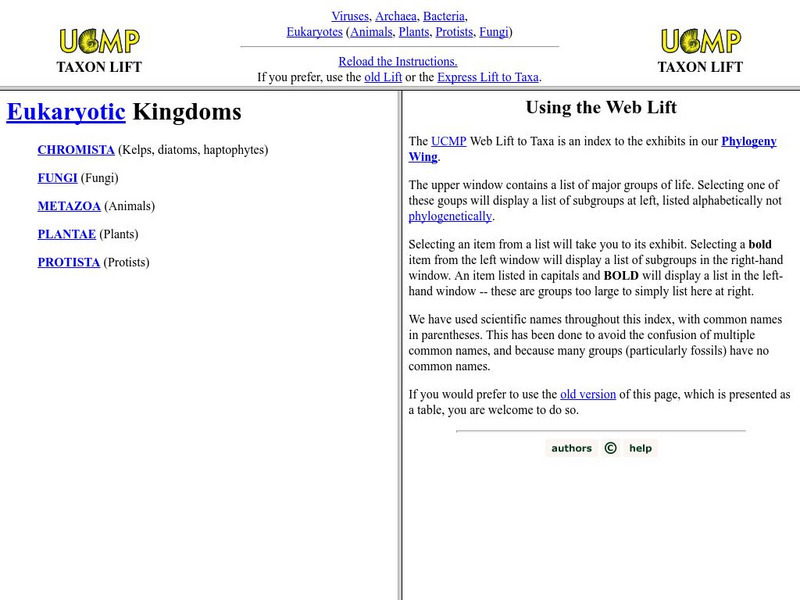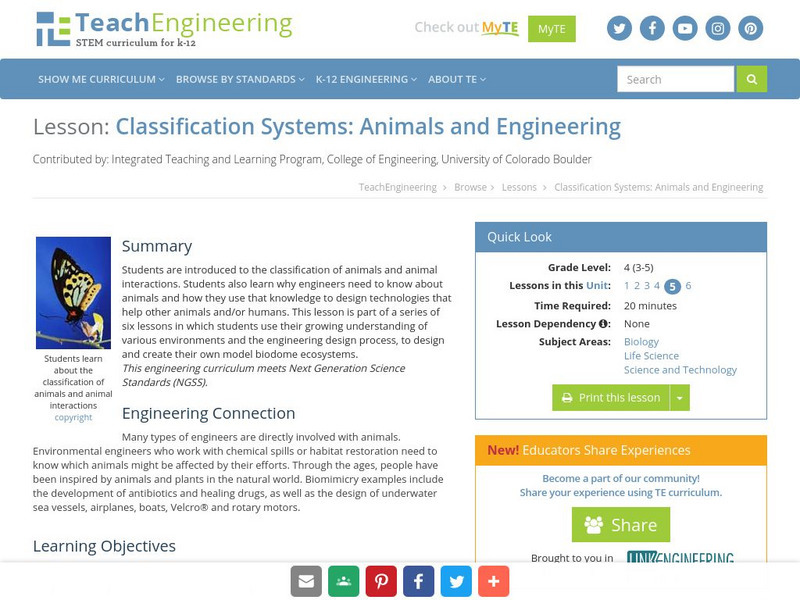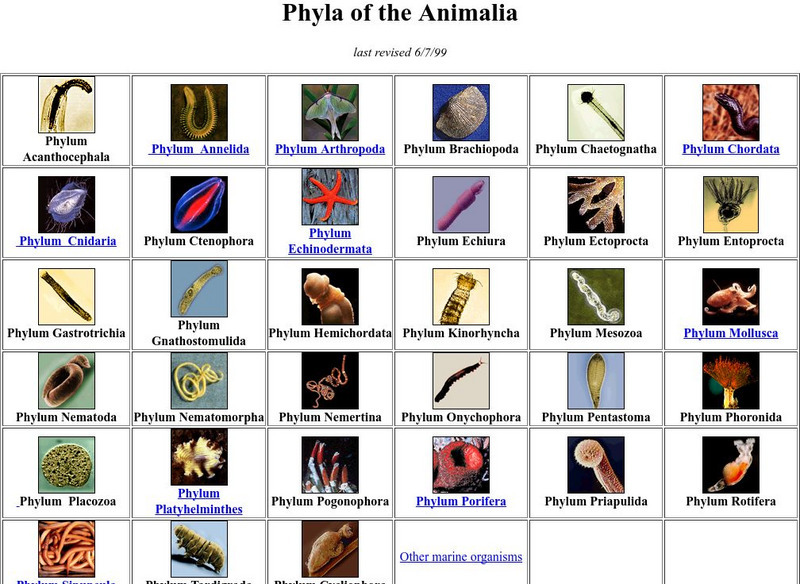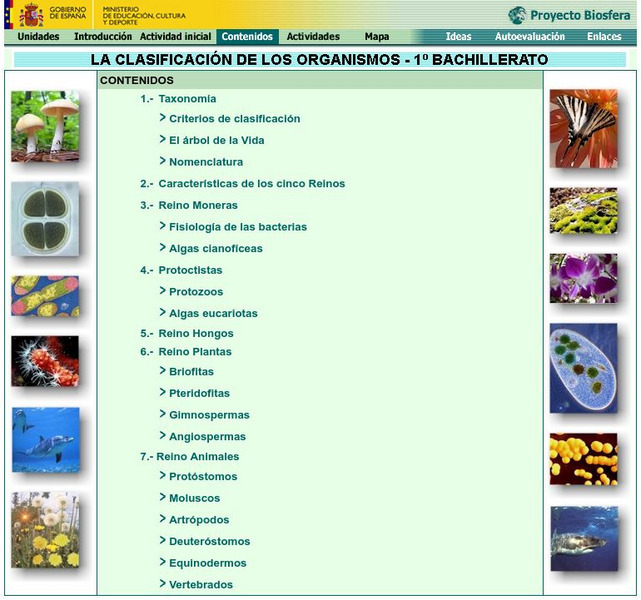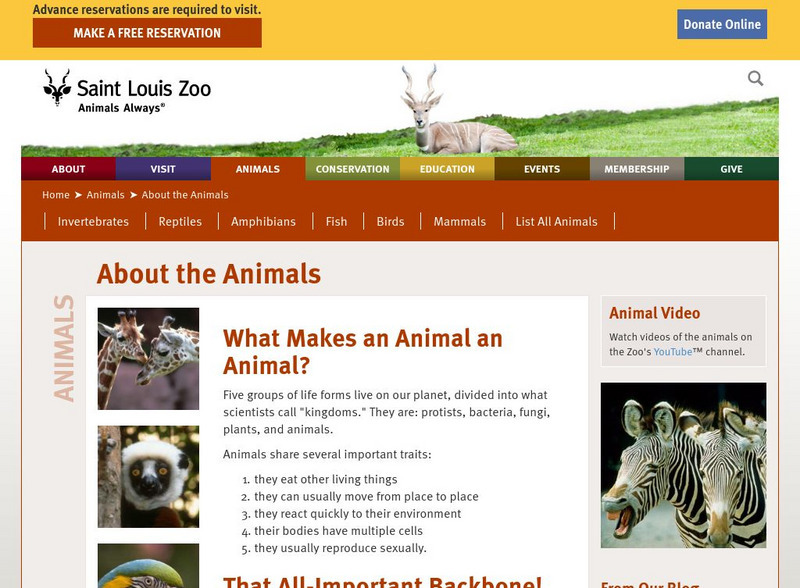Other
Old Farmer's Almanac: What to Call a Group of Animals?
What do you call a group of tigers? How about a group of crows? This list will tell you these animal group names along with over a hundred more.
PBS
Pbs Nature Critter Guide: Mammals: Aardvarks
This PBS Critter Guide gives a brief description of the aardvarks life and habitat. This site would be useful for students who need help narrowing their Internet research information into a manageable amount.
Science Buddies
Science Buddies: How Biodiverse Is Your Backyard?
In this science activity, you will investigate the diversity (or biodiversity) of the animal life around your home and try to figure out which phylum most of the animals belong to.
Biology 4 kids
Biology4 Kids: Anemone and Coral the Cnidarians
An overview of the Phylum Cnidaria highlights the general characteristics of these strange creatures from the Animal Kingdom.
ClassFlow
Class Flow: South Carolina Animals
[Free Registration/Login Required] The flipchart explores habitats that support the different kinds of animals that live in the state. Students match pictures of animals to their habitats, unscramble letters to find the names of the...
ClassFlow
Class Flow: Vertebrates and Invertebrates
[Free Registration/Login Required] Using this lesson the students will review the 2 groups of animals - vertebrates and invertebrates. They will be actively involved in classifying animals. An Activote assessment is also included.
Alabama Learning Exchange
Alex: Animal, Insect, and Bird Classification
As a follow-up to a unit on the classifications of animals, insects, and birds, students will attend a distance learning field trip. The students will then e-mail trusted adults some of the information learned about the classification of...
University of California
Ucmp: Web Lift to Taxa
Alphabetical listing from the University of California of info on each of the animal phyla. Includes scientific and common names and photos. Characteristics of each group are explained in detail.
CK-12 Foundation
Ck 12: Third Grade Science: Life Sci: Animal Characteristics and Classification
[Free Registration/Login may be required to access all resource tools.] Presents an overview of the major animals groups (mammals, birds, reptiles, amphibians, fish, arthropods, vertebrates, invertebrates, those having live births and...
TeachEngineering
Teach Engineering: Animals and Engineering
Students are introduced to the classification of animals and animal interactions. Students also learn why engineers need to know about animals and how they use that knowledge to design technologies that help other animals and/or humans....
My Science Site
Middle School Science: Shoe Classification Lab [Pdf]
This concise worksheet site will enable students to learn how to create a classification system and to understand the reasons for classification in science. Requires Adobe Reader.
Columbia University
Columbia University: Phyla of the Animalia
Visual and textual information of the major animal phyla with a focus on marine organisms.
CK-12 Foundation
Ck 12: Life Science: Organization of Living Things
[Free Registration/Login may be required to access all resource tools.] When you see an organism that you have never seen before, you probably put it into a group without even thinking. If it is green and leafy, you probably call it a...
National Institute of Educational Technologies and Teacher Training (Spain)
Ministerio De Educacion: La Clasificacion De Los Organismo
This unit will describe the five kingdoms and their main characteristics. It includes 20 interactive activities.
Open Curriculum
Open Curriculum: New Kingdoms
Between 1866 and 1977, a total of four new kingdoms were added to the original plant and animal kingdoms identified by Linnaeus. The new kingdoms include Protista (protists), Fungi, Monera (eubacteria), and Archaea (archaebacteria)....
Scholastic
Scholastic: Study Jams! Science: Animals: Kingdoms of Life
A playful interactive introducing biology's five animal kingdoms. Watch the video, take a quiz, and review vocabulary.
Scholastic
Scholastic: Study Jams! Science: Plants: The Kingdoms of Life
A video, a karaoke song to sing along to, and a 7-question multiple-choice quiz on the topic of Kingdoms in the life classification system.
Biology 4 kids
Biology4 Kids: The Top Four Kingdoms
Read about the four most familiar kingdoms: fungi, plant, animal, and protist.
Canadian Wildlife Federation
Hinterland Who's Who: Wildlife
Find an wide range of information on an incredibly wide range of species in Canada, including those that are at risk.
Saint Louis Zoo
Saint Louis Zoo: About the Animals: What Makes an Animal an Animal?
Short introduction to animals explains the important traits that all animals share and the differences between vertebrates and invertebrates.
E-learning for Kids
E Learning for Kids: Science: Caribbean Sea: Mexico: What Is Classifying?
Christina wants to classify all kinds of different things. Help her sort things into main groups.
TED Talks
Ted: Ted Ed: Meet the Tardigrade, the Toughest Animal on Earth
This 1-millimeter animal can survive both the hottest and coldest environments on earth, and can even withstand high levels of radiation. Thomas Boothby introduces us to the tardigrade, one of the toughest creatures on Earth. [4:10]
Defenders of Wildlife
Defenders of Wildlife: Fact Sheets
Here you can find fact sheets on over 50 species of animals. Find an animal by where it lives in the world, and learn all about it.
Other popular searches
- Plant Animal Classification
- Animal Classification System
- Animal Taxonomy Game
- Animal Classification Test
- Animal Classification Fish
- Animal Classification Units
- Classifying Animals Chart
- Diversity of Animal Kingdom
- Animal Classification Lesson
- Classifying Animal Groups
- 5e Animal Classification
- Science Classifying Animals








